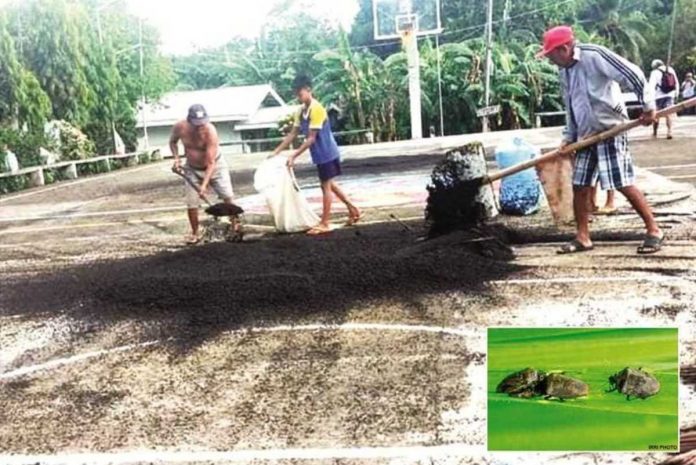
ILOILO – Rice black bugs are infesting rice fields in three towns, according to the Provincial Agriculture Office (PAO).
The bugs feed on rice plants from their seedling up to the maturity stage. These pests are highly destructive and thrive in well-irrigated but poorly-drained areas.
Concepcion town in northern Iloilo was the first to report. Residents recently collected sacks of rice black bugs in Barangay Aglosong.
Dr. Ildefonso Toledo, PAO chief, said the barangay held a basketball tournament at night and bright lights attracted the rice black bugs.
“Pareho man sa natabu sa Ajuy sang 2005 or 2006 nga may liga man sa barangay… Because sang kasanag sang ila suga, nag-swarm ang rice black bugs. Amo na natabu sa Concepcion,” explained Toledo in an interview with Panay News.
Residents shoveled and buried the rice black bugs.
Toledo also received verbal reports from the towns of Cabatuan and Pototan in the 3rd District that there were sightings of rice black bugs in their fields.
But he is still waiting for the official report from the municipal agriculture office (MAO) of the two towns to determine the extent of damage to rice and other plants.
Cabatuan and Pototan have large rice fields.
Why do rice black bugs appear?
Toledo said rice black bugs come out during the dry season.
“Naga-gwa ina sila during summer kag may pagbangag ang duta kay ara man lang sila nagatinir sa rice field kag ara sa puno sang humay,” he added.
The PAO chief is quite relieved that almost all the rice planted in the province had been harvested.
But Toledo explained that once there are rice black bugs in an area, they cannot be totally eradicated; they lay eggs, turn into larvae and then mature, creating a cycle.
And, since there are plants in the fields as other farmers have ventured into corn or monggo beans, rice black bugs still have alternative food to survive.
How do rice black bugs attack?
Rice black bugs eat the leaves and absorb the juices and sap of the rice, causing the plant to wither.
“Wala na sang juices kag sap ang imo humay, gin-urot na suyop sang rice black bugs. So nagaputi lang na sia, meaning laya na ina sia, kag kon maglaya na ina sia no chance of recovery,” said Toledo.
The International Rice Research Institute has the following suggestions to determine if rice plants are being attacked by rice black bugs:
* Check leaves for discoloration. Black bug damage can cause reddish brown or yellowing of plants. Leaves also have chlorotic lesions.
* Check for decreased tillering. Bugburn symptoms show wilting of tillers with no visible honeydew deposits or sooty molds.
* Plants are also stunted; and can develop stunted panicles, no panicles, incompletely exerted panicles, and unfilled spikelets or whiteheads at the booting stage.
* Check for deadhearts.
Deadhearts can also be caused by stemborer. To confirm the cause of damage, pull infected plants. In black bug damage, infected plants cannot be pulled at the bases.
Heavy infestation and “bug burn” is usually visible after heading or maturing.
Measures vs rice black bugs
According to Toledo, farmers can do two things to eradicate rice black bugs.
First is the setting up of high-wattage lights to attract rice black bugs, or “light trapping”. Once the rice black bugs gather, put them in a sack and bury them.
Light trapping of insects should start five days before and after the full moon, experts recommend. Use 2,000 to 3,000 watts or super light during outbreaks and set them up every night to obtain the most bugs.
Effective light trapping is from 8 p.m. to 12 midnight, according to experts.
Toledo does not encourage spraying insecticides or pesticides.
“I’m not encouraging nga magamit sang insecticides and pesticides kay ang aton friendly insects madala man nga magkalamatay, indi lang rice black bugs,” the PAO chief explained.
Second, irrigate the field so that the rice black bugs escape and their eggs are less likely to survive.
Toledo is also pushing the farmers to synchronize planting so that the rice black bugs will have nowhere to transfer to.
But he admitted it will be difficult to implement synchronized planting because most of the rice fields are rainfed.
Toledo hopes that once the Jalaur River Multi-purpose Project Stage II is completed, farmers can synchronize planting because there is enough water for irrigation.
In the meantime, the PAO chief reminded farmers to be vigilant.
“I-observe lang nila ang protocols sa rice farming, and as much as possible, indi lang mag-spray,” said Toledo. (With reports from PhilRice, IRRI, topbest.ph)/PN



